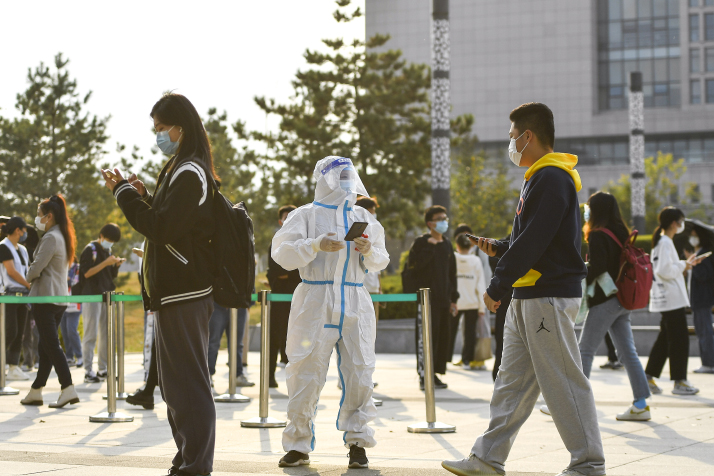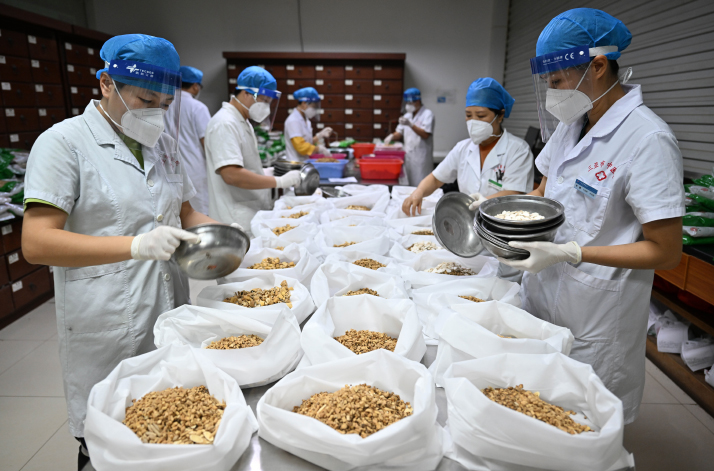| China |
| Measures laid out to optimize COVID-19 control | |
|
|
 A staff member guides residents at a nucleic acid testing site in Changchun, Jilin Province, on October 2 (XINHUA)
All passengers arriving from overseas will undergo five days of quarantine at designated sites plus three days of home quarantine, reduced from the previous seven-day quarantine at designated sites plus three-day health monitoring at home, according to a notice released by the State Council Joint Prevention and Control Mechanism Against COVID-19 on November 11, laying out 20 measures aimed at optimizing pandemic control.
The notice was released following a meeting held by the Standing Committee of the Political Bureau of the Communist Party of China (CPC) Central Committee on November 10, which produced the 20 measures after hearing a report on COVID-19 prevention and control. Xi Jinping, General Secretary of the CPC Central Committee, presided over the meeting. These measures would make COVID-19 prevention and control more scientific and targeted, so as to protect people's lives and health to the greatest extent, and minimize the impact of the pandemic on economic and social development, Fu Linghui, spokesperson of the National Bureau of Statistics, said on November 15 at a press conference on the country's recent economic performance.  Pharmacists prepare traditional Chinese medicinal herbs for COVID-19 patients at a hospital in Sanya, Hainan Province, on August 20 (XINHUA)
Coordinating tasks In addition to shortened quarantine periods for inbound travelers, the notice read quarantine periods for close contacts of confirmed cases (cases presenting symptoms) have been cut to five days of quarantine at designated sites plus three days of home quarantine, from the previous seven days of quarantine at designated sites plus three days of health monitoring at home. Secondary close contacts of confirmed cases will no longer be identified. The categories of COVID-19 risk areas should be adjusted from high, medium and low, to high and low to minimize the number of personnel in quarantine or under health monitoring. The notice scrapped the previous practice of suspending flight routes if inbound international flights on those routes carried a certain number of COVID-19 cases, and changed the negative COVID-19 test result requirement for inbound travelers from twice in the 48 hours before boarding to once. The notice said that inbound high-level business travelers and sports groups arriving in China from overseas should be exempted from quarantine and directly transferred to closed-loop bubbles via designated vehicles. The meeting on November 10 underlined the need to continue to prioritize lives and health in addressing the pandemic. It emphasized the need to continue the strategy of preventing both inbound cases and domestic resurgences and adhering to the policy of dynamic zero-COVID-19. With the overarching goal of preventing inbound infections and domestic flare-ups, this policy means that when a new local outbreak occurs, measures will be taken to promptly stem the spread of the virus and clear new infections. It does not denote zero infection. The gist is to cut off the spread of new infections as soon as possible, instead of risking the virus spinning out of control. The meeting noted that, at present, the coronavirus is still mutating, the global pandemic is still ongoing and there have been resurgences of the virus in China. China has a huge population and a large number of vulnerable groups and its development is unbalanced between its regions. The nation's healthcare resources would be insufficient to provide proper treatment to the many in need, should the virus take hold across China. New strains of the virus and its relatively higher prevalence in winter and spring when the weather is colder pose serious challenges to prevention and control efforts. In November, the Chinese mainland saw a rise in the number of positive cases. The daily number of locally transmitted confirmed cases rose from 498 on October 31 to 1,133 on November 9, the day before the 20 measures were released, and to 1,568 on November 15, according to the National Health Commission (NHC). On November 15, 18,491 local asymptomatic carriers were newly identified. The meeting also highlighted the importance of coordinating COVID-19 prevention efforts with economic and social development and minimizing the impacts of the pandemic on economic and social development. Lei Haichao, deputy head of the NHC, said at a press conference on November 12 that the measures will help divert limited COVID-19 response resources to people and areas at higher risks of virus transmission. By doing so, outbreaks can be contained as quickly as possible with minimum expenses. Evidence-based adjustments The 20 new measures are based on practical experience and assessment data, according to Lei. Zhang Boli, a senior traditional Chinese medicine expert and a member of the Chinese Academy of Engineering, told Science and Technology Daily on November 14 that the mutation of the virus has been an important basis for the adjustment of COVID-19 response measures. Clinical experience shows that the rate of critical cases and deaths caused by the virus is very low at present and most of the current positive cases are asymptomatic. Vaccine-induced herd immunity has been formed in China as more than 90 percent of its total population have been fully vaccinated, including more than 85 percent of its senior population. He added that according to what is known about virus mutation, the virus is likely becoming more stable and less virulent. The shortening of the quarantine period is based on evidence, Chang Jile, deputy head of the Disease Prevention and Control Bureau under the NHC, said at the press conference. The incubation period of new strains is gradually reducing; as the longest period of incubation for the Omicron variants is around eight days, five days of centralized quarantine plus three days of home quarantine is adequate to control the risk of infection, Chang added. The decision not to trace secondary contacts of confirmed cases is also based on science. Chang said secondary close contacts have an extremely low rate of infection—3.1 in 100,000—therefore they will no longer be traced. Medium risk areas also have had a low rate of positive cases—3 in 100,000—but designating such areas would cause a large number of people to be under quarantine and result in a waste of human resources for pandemic control at the community level. The notice requires more precise identification of high-risk areas. It said high-risk areas will cover residences of positive cases and places they have frequently visited, and should be limited to a certain building and should not be expanded recklessly. If no new cases are detected for five consecutive days, the high-risk label along with control measures should be lifted promptly. The notice required more efforts in enhancing medical resources. Vaccination against COVID-19 should be advanced in an orderly manner, it said, adding booster vaccination coverage should be stepped up, especially for seniors. The document also urged the stepping up of services to minimize interruptions to the life of those in quarantine. An Baojun, an official with the Ministry of Commerce, said at the press conference that the ministry will continue to strengthen market monitoring. He also said large supermarkets and agricultural product wholesale markets should identify potential temporary alternative locations in case of flare-ups. (Print Edition Title: Targeted Responses) Copyedited by G.P. Wilson Comments to jijing@cicgamericas.com |
|
||||||||||||||||||||||||||||
|